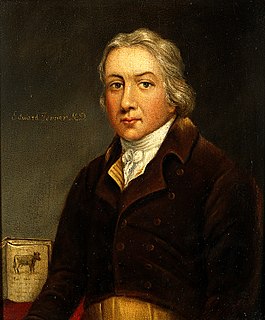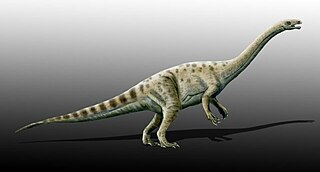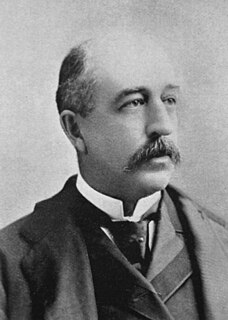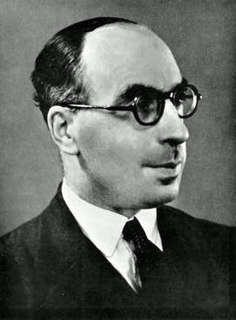Related Research Articles

Edward Jenner, was an English physician and scientist who pioneered the concept of vaccines including creating the smallpox vaccine, the world's first vaccine. The terms vaccine and vaccination are derived from Variolae vaccinae, the term devised by Jenner to denote cowpox. He used it in 1798 in the long title of his Inquiry into the Variolae vaccinae known as the Cow Pox, in which he described the protective effect of cowpox against smallpox.

A quarantine is a restriction on the movement of people, animals and goods which is intended to prevent the spread of disease or pests. It is often used in connection to disease and illness, preventing the movement of those who may have been exposed to a communicable disease, but do not have a confirmed medical diagnosis. It is distinct from medical isolation, in which those confirmed to be infected with a communicable disease are isolated from the healthy population. Quarantine considerations are often one aspect of border control.

Cochrane is a British international charitable organisation formed to organise medical research findings to facilitate evidence-based choices about health interventions involving health professionals, patients and policy makers. It includes 53 review groups that are based at research institutions worldwide. Cochrane has approximately 30,000 volunteer experts from around the world.

The Worshipful Company of Barbers is one of the Livery Companies of the City of London, and ranks 17th in precedence.
dnaQ is the gene encoding the ε subunit of DNA polymerase III in Escherichia coli. The ε subunit is one of three core proteins in the DNA polymerase complex. It functions as a 3’→5’ DNA directed proofreading exonuclease that removes incorrectly incorporated bases during replication. dnaQ may also be referred to as mutD.

Shotover is a hill and forest in Oxfordshire, England.
James Edgar Till, is a University of Toronto biophysicist, best known for demonstrating – with Ernest McCulloch – the existence of stem cells.

The Maudsley Hospital is a British psychiatric hospital in south London. The Maudsley is the largest mental health training institution in the UK. It is part of South London and Maudsley NHS Foundation Trust, and works in partnership with the Institute of Psychiatry, King's College London. The hospital was one of the originating institutions in producing the Maudsley Prescribing Guidelines. It is part of the King's Health Partners academic health science centre and the National Institute for Health Research (‘NIHR’) Biomedical Research Centre for Mental Health.

Medical education is education related to the practice of being a medical practitioner, including the initial training to become a physician and additional training thereafter.

Peel Island is a small heritage-listed island located in Moreton Bay, east of Brisbane, in South East Queensland, Australia. The island is a locality within the local government area of Redland City. In the 2016 census, Peel Island had a population of 0 people.

Massospondylidae is a family of early massopod dinosaurs that existed in Asia, Africa, North America, South America and Antarctica during the Late Triassic to the Early Jurassic periods. Several dinosaurs have been classified as massospondylids over the years. The largest cladistic analysis of early sauropodomorphs, which was presented by Apaldetti and colleagues in November 2011, found Adeopapposaurus, Coloradisaurus, Glacialisaurus, Massospondylus, Leyesaurus and Lufengosaurus to be massospondylids. This result supports many previous analyses that tested fewer taxa. However, this analysis found the two recently described North American massopods, Sarahsaurus and Seitaad, and the South African Ignavusaurus to nest outside Massospondylidae, as opposed to some provisional proposals. Earlier in 2011, Pradhania, a sauropodomorph from India, was tested for the first time in a large cladistic analysis and was found to be a relatively basal massospondylid. Mussaurus and Xixiposaurus may also be included within Massospondylidae. In 2019, a specimen previously assigned to Massospondylus from South Africa was re-examined and found to belong to a separate genus that was named Ngwevu.

Frederick Montizambert, was a Canadian physician and civil servant. He was the first Director General of Public Health in Canada.
John Jacob Cannell, M.D. is an American doctor. An anti-smoking activist, Cannell was featured in the New York Times in the 1980s for turning away smokers from his clinic in West Virginia. Cannell founded a nonprofit group to address perceived problems with educational testing. Cannell has described several hypotheses regarding the health benefits of Vitamin D and is the founder of the Vitamin D Council.

HMS Lizard was a 28-gun Coventry-class sixth-rate frigate of the Royal Navy, in service from 1757 to 1828. Named after the Lizard, a peninsula in southern Cornwall, she was a broad-beamed and sturdy vessel designed for lengthy periods at sea. Her crewing complement was 200 and, when fully equipped, she was armed with 24 nine-pounder cannons, supported by four three-pounders and twelve 1⁄2-pounder swivel guns. Despite her sturdy build, she was plagued with maintenance problems and had to be repeatedly removed from service for repair.

Henry Roy Dean, MD, LL.D, D.Sc, FRCP, also known as Prof. H. R. Dean, was a professor of Pathology at the University of Cambridge and Master of Trinity Hall, Cambridge.

William Sidney Charles Copeman was a rheumatologist and a medical historian, best remembered for his contributions to the study of arthritic disease.
Medical History is an open-access peer-reviewed journal of history of medicine. It was established in 1957. The journal is edited by Sanjoy Bhattacharya and is published by Cambridge University Press.
The Leprosy Act was an act of the Parliament of Canada regarding the establishment and direction of lazarettos, or leper homes, in Canada to ensure the segregation and treatment of people afflicted with leprosy. The Leprosy Act gave responsibility to the Minister of Agriculture for the management of the lazarettos, apprehension and confinement of the ill, capture of escaped inmates, and punishment of those found to be harbouring or concealing a person afflicted with leprosy.

Dimethylcarbamoyl fluoride is a chemical compound that can be produced by fluorinating the dimethylcarbamoyl chloride with potassium fluoride. It's a colorless liquid that is soluble and stable in water.

William John Bishop FLA was a British librarian, the first editor of the journal Medical History, and a prolific writer. With his friend Frederick Noël Lawrence Poynter, he wrote about John Symcotts, a medical attendant of Oliver Cromwell in A Seventeenth Century Doctor and his Patients: John Symcotts, 1592?–1662.
References
- ↑ Booker, John (2016). Maritime Quarantine: The British Experience, c.1650–1900. Abingdon: Routledge.
- ↑ Froggatt, P. (January 1964). "The Lazaret on Chetney Hill". Medical History. 8 (1): 44–62. doi:10.1017/S0025727300029082. PMC 1033335 . PMID 14105431.
- ↑ Kent County Council (25 January 2008). "Exploring Kent's Past". webapps.kent.gov.uk. Retrieved 24 April 2019.
- ↑ Froggatt, Peter (1964). "The Lazaret on Chetney Hill". Medical History. 8: 44–62. doi:10.1017/s0025727300029082. PMC 1033335 . PMID 14105431. S2CID 37072712.
- ↑ An Act (passed 28th July 1800,) for Erecting a Lazaret, on Chetney Hill, in the County of Kent; and for Reducing Into One Act the Laws Relating to Quarantine, ... and Also an Order in Council, Dated 29th July 1800. George Eyre and Andrew Strahan. 1800.
Coordinates: 51°23′49″N0°42′14″E / 51.3969°N 0.7039°E
| This article about a Kent building or structure is a stub. You can help Wikipedia by expanding it. |